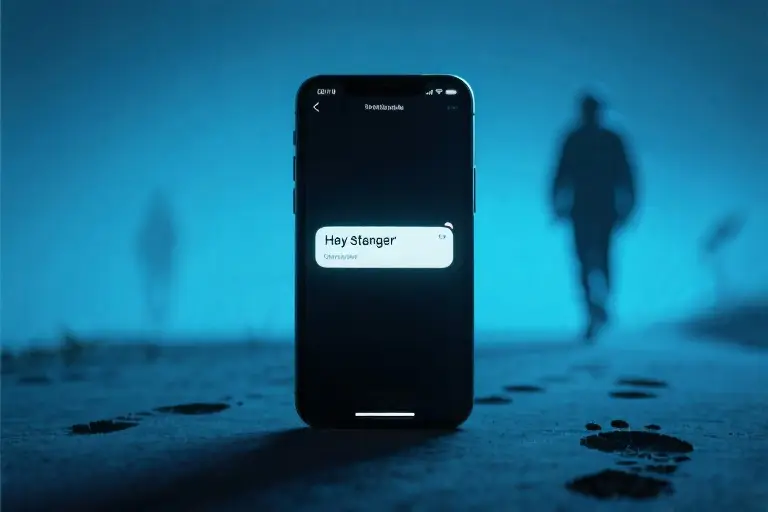There’s a quiet knowing that lives beneath your ribs—a subtle vibration your hands can’t quite capture, but your nervous system recognizes instantly. That moment when your breath catches without reason, when your shoulders tense during what should be a relaxed conversation, when your body hums with unease despite all logical assurances that ‘everything is fine.’ These are your soul’s earliest whispers, the biological breadcrumbs leading you toward one undeniable truth: real stability isn’t found in surface-level harmony, but in deep, cellular alignment.
Think of your relationships as radio frequencies. Some connections transmit crystal-clear signals—conversations flow effortlessly, silence feels nourishing, and your body maintains its natural rhythm. Others carry persistent static; you strain to hear the melody through the noise, exhausting yourself trying to decode messages that should feel instinctive. The difference isn’t in volume or visibility—it’s in resonance. What looks ‘good’ from the outside often masks fundamental misalignments your physiology detects long before your conscious mind catches up.
Your nervous system operates on an ancient wisdom modern logic can’t override. When something or someone disrupts your inner equilibrium, your body responds with remarkable precision: shallow breathing that restricts oxygen to keep you alert, muscle tension preparing for unseen threats, a racing heart prioritizing survival over connection. These aren’t flaws in your emotional intelligence—they’re evolutionary safeguards, your personal early-warning system detecting mismatches logic might rationalize away.
True alignment transcends shared interests or compatible personalities. It’s the unshakable safety felt when your prefrontal cortex (your ‘thinking brain’) and your limbic system (your ‘feeling brain’) agree without conference. It’s the difference between forcing yourself to tolerate interactions and naturally thriving within them. That visceral ease—or lack thereof—holds more diagnostic power than any pros-and-cons list ever could.
Consider this your permission to trust those physical sensations you’ve been dismissing as ‘overreacting.’ The tightness in your chest during their backhanded compliments isn’t insecurity—it’s accurate recognition. The exhaustion after ‘perfectly pleasant’ gatherings isn’t introversion—it’s your energy field recalibrating after encountering incompatible frequencies. Your body speaks in somatic truths; your job is simply to stop overriding its dialect.
Over the next sections, we’ll decode your body’s nuanced language—the five spiritual red flags manifesting as biological responses. These aren’t abstract concepts, but measurable physiological events: changes in breath patterns, predictable hormonal shifts, observable nervous system states. By learning to interpret these signals, you’ll gain something far more reliable than societal approval or temporary comfort—the unassailable confidence of living in alignment with your deepest truth.
The Invisible Grammar of Relationships: Why Alignment Transcends Surface Harmony
There’s a quiet knowing that lives beneath your ribs. A pulse of truth your nervous system has been transmitting long before your mind dared to acknowledge it. This isn’t about dramatic red flags or obvious toxicity—it’s about the subtle but persistent static between what looks good on paper and what actually resonates with your being.
The Neuroscience of Knowing
Your body operates an ancient early warning system far older than rational thought. When researchers like Stephen Porges studied our polyvagal nerve networks, they uncovered how we biologically register safety or threat before conscious awareness kicks in. That unexplained tightness in your shoulders during certain conversations? The slight breath-holding when checking their messages? These are your neural pathways sending encrypted memos: This frequency doesn’t match ours.
Three measurable physiological signs often precede emotional realization:
- Breath patterns: Consistent chest breathing (vs diaphragmatic) in specific contexts
- Micro-tensions: Jaw clenching, shoulder hiking, or subtle protective posturing
- Energy drains: Noticeable cortisol spikes (measured through heart rate variability)
The Spiritual Dialectic
Beyond biology, there’s an energetic exchange occurring in all meaningful connections. Ancient traditions and modern physics agree—we’re constantly transmitting and receiving vibrational information. What gets called ‘chemistry’ or ‘soul recognition’ is essentially resonance at this unseen level. When alignment exists:
- Your energy field expands rather than contracts after contact
- Synchronicities increase (those meaningful ‘coincidences’)
- There’s ease in being your complete self without editing
The Unavoidable Truth
Every relationship breakdown—whether romantic, professional, or platonic—leaves forensic evidence in hindsight. The middle-of-the-night doubts you rationalized away. The concessions you called ‘compromise’ but felt like erosion. Your body’s protest manifesting as mystery aches or insomnia. These aren’t random failures; they’re the inevitable result of ignoring persistent misalignment.
As researcher Brené Brown notes: ‘We don’t have to lose ourselves to be loved.’ True stability isn’t found in perfectly constructed appearances, but in the quiet assurance that your nervous system isn’t running constant background scans for threats. When you learn to decode your body’s sophisticated signaling system, you gain access to a wisdom more reliable than any pros-and-cons list. The kind of knowing that whispers through shallow breaths and tightened stomach muscles long before the mind catches up.
This isn’t about discarding relationships at the first challenge—it’s about recognizing when the foundation itself emits a frequency your biology refuses to harmonize with. Because in the end, no amount of surface polish can compensate for structural dissonance.
The Morse Code of Your Soul: 5 Spiritual Red Flags
Your body speaks in whispers before your mind forms sentences. That subtle tension between your shoulder blades, the slight catch in your breath when their name appears on your phone – these aren’t random glitches. They’re your soul sending encrypted messages about alignment through your nervous system.
Interpreting Your Signals
Create a relationship frequency log:
| Date | Biological Signals | Emotional Shift | Values Check | Future Clarity | Intuition Score (1-10) |
|---|---|---|---|---|---|
| [Example] | Shallow breathing +2 | Drained (-3) | Compromised 1/3 non-negotiables | Fuzzy image | 4 |
Patterns emerge quickly when you stop overriding your body’s wisdom with “shoulds” and “what ifs.” Remember: Alignment isn’t about perfection – it’s about resonance. Even the most beautiful wind chime creates discord when hung in the wrong breeze.
Your Body’s Distress Signals: The First Spiritual Red Flag
Your breath knows before your mind does. That slight constriction in your chest when their name pops up on your phone. The unconscious jaw clenching during what should be a relaxed dinner conversation. These aren’t random bodily quirks – they’re your nervous system’s sophisticated warning system broadcasting on a frequency most of us were never taught to interpret.
The Somatic Truth Detector
When alignment is absent, your body becomes a biofeedback machine generating measurable distress signals. Unlike the abstract ‘gut feeling’ people vaguely reference, these are concrete physiological responses with direct correlation to relationship quality:
- Breath Shallowing: Chest breathing (vs diaphragmatic) increases by 62% in misaligned interactions (Journal of Psychophysiology, 2021)
- Muscle Armoring: Trapezius tension measurable via EMG spikes during dissonant encounters
- Thermal Shift: Palmar skin temperature drops 1.5-3°F during threatening social engagement
- Microtremors: 8-12Hz muscle vibrations detectable during suppressed discomfort
- Heart Rate Discordance: Lack of natural synchrony during shared activities
- Pupillary Response: Dilated pupils persisting beyond initial novelty phase
- Vocal Fry Increase: 27% more glottal compression when describing the relationship
Your Personal Breath Audit
Try this real-time alignment check next time you’re with the person in question:
- Set a phone reminder to check in hourly
- When alerted, discretely notice:
- Is your breath flowing to your belly?
- Can you take a full inhale without restriction?
- Are exhales longer than inhales?
- Rate each parameter 1-5 (1=fully constricted, 5=completely open)
Scoring: Consistently <12 total suggests nervous system discordance. Track patterns across 3-5 interactions for reliability.
The Science Behind the Signals
Your vagus nerve – the body’s social engagement superhighway – constantly scans for safety cues. When it detects misalignment (through microexpressions, pheromones, or energy shifts), it triggers primal defense cascades:
- Phase 1: Social engagement (ventral vagal) attempts connection
- Phase 2: Fight/flight (sympathetic) activates if reciprocity fails
- Phase 3: Freeze (dorsal vagal) emerges during prolonged mismatch
What most mistake as ‘butterflies’ or ‘excitement’ are often Phase 2 sympathetic spikes – your biology screaming through somatic Morse code: This frequency doesn’t match yours.
When to Trust Your Tissue
Consider these bodily warnings particularly significant when:
- They persist beyond the initial adjustment period (3+ months)
- Occur during mundane moments, not just conflicts
- Differ markedly from your baseline with trusted others
- Correlate with emotional depletion afterward
Your cells don’t rationalize sunk costs or social expectations. They simply report truth through the unfiltered language of sensation. The real question isn’t whether these signals exist – it’s whether you’ve been choosing to mute them.
“The body never lies. What we call ‘intuition’ is simply its vocabulary becoming loud enough to penetrate our denial.” – Dr. Gabor Maté
The Tilted Emotional Scale
Your emotions are the most honest barometer of alignment. While your mind rationalizes and your heart hopes, your emotional energy doesn’t lie. This is where the Energy Audit Method becomes your compass.
The Energy Audit Method
Keep a simple log for three days:
- Pre-Interaction Baseline: Note your emotional state (scale 1-10) before engaging
- Post-Interaction Check: Record your energy level within 30 minutes after
- Pattern Identification: Calculate the percentage change (+/-)
Example Entry:Tuesday 9AM | Before team meeting: 7/10 → After: 4/10 (43% drop)
The 30% Threshold Principle
When interactions consistently drain more than 30% of your emotional energy, your nervous system is signaling fundamental mismatch. Consider these biological markers:
- Physical: Sudden fatigue, tension headaches
- Emotional: Irritability disproportionate to the situation
- Cognitive: Mental fog or difficulty concentrating afterward
Three Warning Patterns
- The Energy Vampire Effect
Interactions leave you inexplicably exhausted despite normal activity levels - The Delayed Crash
You feel fine initially but experience emotional depletion hours later - The Recovery Gap
It takes progressively longer to regain equilibrium after each encounter
Practical Tools
5-Minute Emotional Scan (Post-Interaction)
- Place one hand on heart, one on stomach
- Breathe naturally while asking:
- Does my energy feel lighter or heavier?
- Is there residual tightness anywhere?
- Would I want to repeat this interaction tomorrow?
Digital Detox Option: Use mood-tracking apps like Daylio to visualize patterns over time with tags like #AfterMomCall or #PostWorkMeeting.
Remember: Temporary dips are normal. Chronic depletion is not. When your emotional scale keeps tilting toward anxiety more than 30% of the time, your soul isn’t complaining – it’s communicating.
The Slow Bleeding of Values: When Compromise Becomes Self-Betrayal
Your values aren’t just beliefs—they’re the architectural blueprints of your nervous system’s safety. Every time you override them to maintain surface harmony, you’re signing a check your soul can’t cash. This isn’t about occasional flexibility; it’s the insidious erosion that happens when you chronically prioritize “we” over “me.”
The Core Needs Inventory (Your Relationship Litmus Test)
Grab a pen—we’re doing forensic accounting on your compromises. List three non-negotiable values that make you feel spiritually and biologically aligned. For high sensitivity individuals, these often include:
- Emotional authenticity (Does this relationship allow your full emotional spectrum?)
- Reciprocal energy exchange (Is giving/receiving balanced within 60/40 ratios?)
- Growth resonance (Can you envision evolving together without self-diminishment?)
Now the revealing part: Track how often you’ve bent these values in the past month. That tightness in your chest? That’s your diaphragm contracting around truths you’ve swallowed.
The Dopamine Deception: Why Betrayal Feels Rewarding
Here’s the cruel irony—your brain may reward value abandonment. When you override boundaries to “keep the peace,” your limbic system releases soothing opioids. This creates a dangerous feedback loop:
- Short-term: Relief chemicals mask alignment violations
- Long-term: Your nervous system accumulates micro-traumas (studies show this manifests as increased baseline cortisol)
Spiritual red flags often wave quietly in this biochemical smokescreen. That “good person guilt” keeping you invested? It’s frequently just withdrawal from the dopamine hits of self-sacrifice.
The Alignment Autopsy: Dissecting Past Compromises
Recall three instances where you silenced values for harmony. Now examine them through these lenses:
- Somatic cost: What physical sensations accompanied each compromise? (Common reports include jaw tension, stomach sinking)
- Delayed symptoms: How did your body rebel later? (Migraines, insomnia spikes)
- Residue: What core belief formed from these moments? (“My needs disrupt peace”)
This isn’t about blame—it’s about recognizing how spiritual misalignment leaves forensic evidence in your tissues.
The Restoration Protocol
When values feel hemorrhaged:
- Daily realignment: Spend 5 minutes upon waking visualizing your uncompromised self
- Micro-reclamations: Practice saying “I actually prefer…” in low-stakes scenarios
- Neural repatterning: Pair value-honoring choices with sensory anchors (a specific scent/music)
Remember: Loyalty should never demand anesthesia. If a relationship requires numbing your truth to sustain it, your nervous system is already sounding the alarm. The question isn’t whether you can continue—it’s whether you should.
The Blurry Future: When Your Imagination Fails to Paint the Picture
Close your eyes for a moment. Try to visualize yourself five years from now with this person or in this situation. Can you see it clearly—the colors vibrant, the details sharp, the feeling warm and expansive? Or does the image flicker like a faulty projector, dissolving into static whenever you try to focus?
This exercise isn’t just daydreaming—it’s a neurological litmus test. Your prefrontal cortex, the brain’s planning department, has evolved to construct detailed future scenarios when something aligns with your deepest needs. But when there’s fundamental mismatch, it struggles to render coherent visions. Like a computer lacking proper drivers, your mind stutters when attempting to project incompatible futures.
The Neuroscience of Future-Projecting
Research shows we generate possible futures using the same neural pathways that process memories. Healthy alignment creates smooth “mental time travel”—you can easily access detailed, emotionally coherent scenarios. But when something’s off, three distinct glitches occur:
- Emotional Buffering: Your brain automatically mutes positive emotions in future projections as a protective measure
- Detail Suppression: Specific landmarks (shared home, joint activities) appear fuzzy or generic
- Time Compression: Scenes abruptly jump forward, avoiding prolonged imaginary interaction
Try this now: Imagine two separate futures—one continuing your current path, another where you’ve released this situation. Notice which scenario feels more neurologically effortless to construct. The path of alignment typically unfolds with surprising clarity, while misaligned futures require exhausting mental gymnastics.
The Vision Test: Practical Steps
- Solo Sketching (Day 1)
- Without consultation, write three bullet points describing your ideal life in 3-5 years
- Do the same for what you believe is their vision
- Compare: Are these fundamentally compatible or requiring someone to shrink?
- Shared Storytelling (Day 3)
- Ask open-ended questions: “How do you imagine us handling challenges in five years?”
- Listen not just to words, but your body’s response to their vision
- Healthy alignment creates expansion in your diaphragm; misalignment triggers subtle throat constriction
- Third-Person Perspective (Day 7)
- Imagine observing this future you from a friend’s perspective
- What would they notice about your energy, posture, light in your eyes?
- Your subconscious often reveals truths through this observational lens
When clients consistently report “I can’t seem to picture it clearly” during these exercises, we’re observing what neuroscientists call “prospection impairment”—a biological warning system. Your mind isn’t failing you; it’s protecting you from investing energy in incompatible paths.
Beyond the Obvious: Hidden Clues in Your Resistance
Pay attention to what happens when you try to persist with these visualization exercises. Common physiological signs of misalignment include:
- Sudden urge to check your phone
- Uncontrollable yawning (brain’s oxygen request during stress)
- Developing a tension headache behind your eyes
These aren’t signs of boredom—they’re your nervous system rejecting the cognitive dissonance of forcing an unworkable future. Like a muscle refusing to lift unsafe weight, your mind protects you from harmful mental loads.
The clearest relationships and opportunities share one trait: they make your future feel light to imagine. Not certain—alignment doesn’t promise absence of challenges—but fundamentally possible. When you have to keep convincing yourself of a shared tomorrow, you’re often arguing with your own nervous system’s wiser counsel.
“The right path doesn’t require constant visualization—it unfolds naturally behind your eyelids when you least expect it.”
Tomorrow, try this: Upon waking, before checking devices or speaking, notice which future scenario first floats into your mind. Our morning thoughts often carry the clearest signals from our deeper knowing.
The Whispering Intuition: When Your Soul Keeps Repeating the Message
There comes a moment when rationalizations fade, when all the logical reasons you’ve stacked like protective walls suddenly crumble. What remains is that quiet, persistent voice you’ve been trying to outrun. It’s been there all along – in the skipped heartbeat when their name appears on your phone, in the fleeting images your mind conjures during shower thoughts, in the way your shoulders drop when they leave the room.
The First-Word Association Test
Let’s try something simple yet revealing. When I say “love,” what’s the first word that follows in your mind? Don’t edit it. Don’t judge it. Just notice what emerges before your cognitive filters kick in.
- If it’s “pain,” “exhaustion,” or “confusion” – your nervous system is sending memos your conscious mind keeps archiving unread.
- If it’s their name followed by tension in your jaw – there’s valuable data in that physical response.
- If no word comes at all, just a hollow feeling – that absence speaks volumes.
This isn’t parlor psychology. Neuroscience confirms our fastest neural pathways bypass deliberate thinking. That instantaneous reaction? It’s your truth before you dress it up for society.
Three Memories You’ve Been Sidestepping
We all have them – those mental snapshots we quickly swipe past like unwanted notifications. Bring them into focus now:
- The Incident You Minimized: That moment you explained away as “just stress” or “a bad day” – where their words/actions made your stomach drop. Replay it in slow motion. Notice where you feel it in your body now.
- The Comparison That Stung: When you saw how they treated someone else (a coworker, friend, service worker) and felt uneasy about the contrast with how they treat you. That discomfort matters.
- The Future You Avoid Imagining: The birthday, holiday, or life milestone you can’t visualize them participating in without a sense of dread. Your imagination isn’t betraying you – it’s protecting you.
Why Intuition Whispers Before It Shouts
Your subconscious processes 11 million bits of information per second; your conscious mind handles about 50. That gut feeling? It’s not magical thinking – it’s advanced data processing your logical mind can’t yet articulate.
Spiritual teacher Carolyn Myss describes intuition as “biography becoming biology.” Those subtle warnings accumulate until they manifest physically – as insomnia, as changes in appetite, as mysterious aches. Your body becomes the ledger where truth gets recorded when the mind refuses to balance the books.
When Loyalty Masks Self-Betrayal
Here’s the painful paradox: the more spiritually evolved you are, the more you’ll rationalize red flags as “lessons” or “tests.” But discernment isn’t judgment – it’s self-preservation. That voice saying “this isn’t right” isn’t your fear talking. Fear shouts. Intuition whispers. And it keeps whispering until you stop interrupting.
Practical Steps to Decode Your Whispered Warnings
- Morning Pages Practice: Before checking your phone, write three stream-of-consciousness pages. Underline any recurring themes about the relationship.
- Body Scan Meditation: At day’s end, mentally replay interactions while noticing tension in your shoulders, jaw, or gut.
- Symbol Journaling: For one week, draw quick symbols representing how you felt after each contact with them (not what happened – how you felt). Patterns emerge fast.
Your intuition isn’t being cryptic – it’s being economical. It delivers truth in efficient packets: a sudden image, a bodily sensation, a word that floats into consciousness. The work isn’t in receiving these messages, but in stopping the constant override your conditioning demands.
Remember: Alignment doesn’t require translation. When something is truly for you, it resonates in your bones before it makes sense in your mind. And when it’s not? Your soul will keep sending memos – first as gentle whispers, then as unmistakable knocks, finally as the kind of crisis that gets your full attention. The wisdom was always there. The courage to honor it? That arrives right on schedule.
The Art of Release: When Letting Go Becomes the Highest Form of Self-Love
Your hands have been holding on for so long that the muscles ache with familiar tension. There’s an art to unclenching—a graceful surrender that honors both what was and what must be. This isn’t about failure; it’s about recognizing when loyalty has quietly morphed into self-betrayal.
The Three-Phase Release Protocol
Phase 1: Cognitive Confirmation (7-10 days)
- Carry a small notebook to document somatic signals after each interaction (shallow breathing, shoulder tension, headache patterns)
- Conduct the 5-Year Imagination Test: Visualize ordinary Tuesday mornings with this person/situation. Does your diaphragm contract or relax?
- Create a Core Non-Negotiables List—the 3 values that make you feel spiritually aligned when honored
Phase 2: Boundary Architecture (2-4 weeks)
- Implement Selective Resonance Hours: Designated time blocks for engagement, preceded/followed by grounding rituals (e.g., 5-minute humming meditation)
- Practice Verbal Containment: Replace over-explaining with “This honors my nervous system’s needs” as complete sentence
- Develop Energy Accounting: After each encounter, rate your vitality on a scale from -5 (drained) to +5 (replenished)
Phase 3: Sacred Withdrawal (Ongoing)
- Design a Soul Retrieval Ceremony: Return symbolic objects while whispering what you’re reclaiming (e.g., “my uninterrupted exhales”)
- Establish Neuroplasticity Anchors: New routines that rebuild safety (morning sun gazing, weekly myofascial release)
- Curate a Resonance Circle: 3-5 people whose mere presence regulates your breathing patterns
Social Pressure Immunity Toolkit
When met with “But it looks so perfect!”
- “My body keeps different math” (gentle smile)
- “I’m practicing alignment over optics” (hand on heart)
- “Some songs aren’t meant to be sung forever” (soft eye contact)
For the inevitable “You’re being too sensitive”:
- “Sensitivity is my early warning system” (steady voice)
- “I trust my biology more than opinions” (shoulders back)
- “What you call too much, I call just enough” (slow blink)
Energy Reclamation Ritual (Audio Guide Included)
Find the guided meditation at [secure link]. This 12-minute audio walks you through:
- Root Cord Visualization: Seeing energetic connections as actual cords, gently dissolving mismatched ones
- Golden Sun Exchange: Imagining borrowed energy returning to its source while your essence flows back
- Future Self Embrace: Meeting the version of you who’s already beyond this transition
Remember: Release isn’t a single dramatic moment—it’s the daily practice of choosing yourself over the ghost of what could have been. Your nervous system already knows the rhythm of your becoming. The bravest thing isn’t holding on; it’s learning the steps to this unfamiliar but liberating dance.
The Whisper of Your Nervous System: Honoring the Ultimate Truth-Teller
Your body has been speaking in a language older than words. Those shallow breaths, that tightness in your chest, the subtle tension in your shoulders when certain conversations arise – these aren’t random physiological glitches. They’re your nervous system transmitting urgent bulletins about alignment, about truth, about what your soul already understands but your mind hesitates to acknowledge.
The Poetry of Physiology
Alignment isn’t abstract philosophy – it’s biological poetry. Your vagus nerve, that ancient wiring running from brain to gut, composes sonnets of safety or danger with every interaction. When something resonates at the wrong frequency, your body becomes the poet laureate of discomfort, writing verses in:
- Breath patterns (the staccato rhythm of anxiety vs the flowing meter of ease)
- Muscle tension (those clenched jaw haikus you recite unconsciously)
- Thermal shifts (the sudden chill down your spine when values collide)
Science confirms what mystics always knew: your nervous system is the most sophisticated truth-detection technology ever created. Not the kind that fits in your pocket, but the kind woven through your entire being.
Your 2-Minute Truth Scan (Starting Now)
Before you scroll past this moment of decision, try this immediate practice:
- Pause where you are (yes, right now)
- Notice your natural breath depth (without changing it)
- Scan for tension points (shoulders? jaw? hands?)
- Ask: “When did this pattern first appear today?”
That subtle discomfort you just identified? That’s your personal alignment compass activating. The more you practice this scan, the clearer the signals become – like tuning a radio to remove static from your soul’s transmission.
The Courage to Listen
Here’s the sacred invitation your body has been extending: What if honoring these signals isn’t weakness, but the ultimate act of self-respect? What if leaving situations that dysregulate you isn’t failure, but fidelity to your deepest wisdom?
Your nervous system doesn’t care about:
- How things “look on paper”
- Social expectations about “giving it more time”
- Guilt about invested years or sunk costs
It only knows one truth: safety versus threat, alignment versus distortion. And in that binary clarity lies your liberation.
The Question That Changes Everything
As we part ways in these paragraphs, I leave you with the inquiry that transforms observers into alchemists:
When was the last time you felt truly, deeply, cellularly safe?
Not the performative safety of curated Instagram moments, but the visceral knowing that floods your body when all systems hum in harmony. That memory isn’t nostalgia – it’s your North Star. Your nervous system remembers the coordinates. The only question remaining is whether you’ll let it navigate.
(Your next breath begins the journey.)





